Study Abroad 2017
In the spring semester of 2017, our class of third year students from the Michigan State University Landscape Architecture Program had the opportunity to study abroad in Europe for seven and a half weeks.

In the spring semester of 2017, our class of third year students from the Michigan State University Landscape Architecture Program had the opportunity to study abroad in Europe for seven and a half weeks.
Visiting Spain, the United Kingdom, and Italy, we learned new methods of design, studied the history and importance of the different locations, and became immersed in the unique culture of each place. Prior to our departure, we were responsible for planning our itinerary for each country and scheduling travel times.
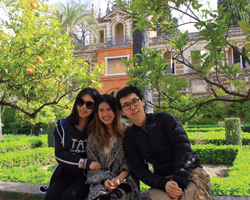 Guided by Dr. Trish Machamer, the program first studied in the Spanish cities of Malaga, Sevilla, Granada, and Madrid. Some of the key places on the itinerary were the Alcazaba, the Real Alcazar, the Alhambra, the Prado Museum, and the Madrid park system. Many of the students used their time to also visit Barcelona, and to experience the Sagrada Familia Cathedral, Casa Mia, and Guell Park.
Guided by Dr. Trish Machamer, the program first studied in the Spanish cities of Malaga, Sevilla, Granada, and Madrid. Some of the key places on the itinerary were the Alcazaba, the Real Alcazar, the Alhambra, the Prado Museum, and the Madrid park system. Many of the students used their time to also visit Barcelona, and to experience the Sagrada Familia Cathedral, Casa Mia, and Guell Park.
Students, split into teams of three, were responsible for selecting a city and acting as a guide to it during our stay. While Spain had its own overall lively atmosphere, each city projected its unique character and identity. Many of the historic landscapes were heavily influenced by Moorish design, and it was very interesting to see the influence of Moroccan culture within the southern parts of Spain.
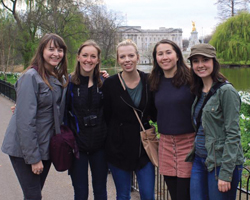 The second destination on our study abroad was the United Kingdom. Under the direction of Dr. Pat Crawford, our class stayed in London for just under one month. Because we were lucky enough to spend a longer time in London, we had the opportunity to really absorb the culture and learn the context of the various designs within the city. Each student was responsible for planning a day of the trip and guiding the class through their destinations while presenting the historical context, design methods, and construction of each location.
The second destination on our study abroad was the United Kingdom. Under the direction of Dr. Pat Crawford, our class stayed in London for just under one month. Because we were lucky enough to spend a longer time in London, we had the opportunity to really absorb the culture and learn the context of the various designs within the city. Each student was responsible for planning a day of the trip and guiding the class through their destinations while presenting the historical context, design methods, and construction of each location.
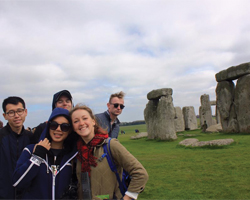 Each student was also responsible for planning the walks between locations, as well as determining sites for sketches. As a class, we had day trips where we ventured outside of the city to places, including Salisbury Cathedral, Stonehenge, Blenheim Palace, Oxford University, Stourhead, and a weekend in Edinburgh, Scotland. Studying abroad in the United Kingdom showed our class that history and modernism can be cohesive within a design, and demonstrated how important concept and purpose are to all design elements.
Each student was also responsible for planning the walks between locations, as well as determining sites for sketches. As a class, we had day trips where we ventured outside of the city to places, including Salisbury Cathedral, Stonehenge, Blenheim Palace, Oxford University, Stourhead, and a weekend in Edinburgh, Scotland. Studying abroad in the United Kingdom showed our class that history and modernism can be cohesive within a design, and demonstrated how important concept and purpose are to all design elements.
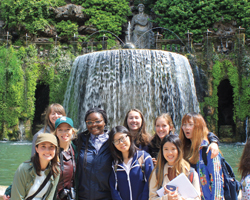 Lastly, our class studied in Italy with Professor Karen Russcher. In Italy, we explored Florence, Venice, Sienna, and Rome. The class was split into teams of two to plan and guide the itinerary for each city. Some of the highlights from the ten days were the Florence Cathedral, the Sienna Cathedral, Piazza del Campo, the Colosseum, Vatican City, the Pantheon, the Spanish Steps, and much more. While very fast-paced, the class was able to absorb the rich culture of Italy while immersed in the endless scenic landscapes.
Lastly, our class studied in Italy with Professor Karen Russcher. In Italy, we explored Florence, Venice, Sienna, and Rome. The class was split into teams of two to plan and guide the itinerary for each city. Some of the highlights from the ten days were the Florence Cathedral, the Sienna Cathedral, Piazza del Campo, the Colosseum, Vatican City, the Pantheon, the Spanish Steps, and much more. While very fast-paced, the class was able to absorb the rich culture of Italy while immersed in the endless scenic landscapes.
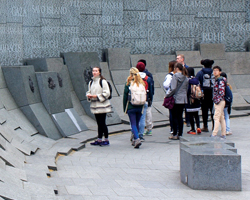 Studying abroad allowed all the students within the program to gain perspective, and taught us the value of culture and concept within design. The free-hand sketching we did together throughout the trip helped each student to really capture moments and look at things differently. Most students have said that they feel more emotionally connected to these places and created vivid memories through their drawings.
Studying abroad allowed all the students within the program to gain perspective, and taught us the value of culture and concept within design. The free-hand sketching we did together throughout the trip helped each student to really capture moments and look at things differently. Most students have said that they feel more emotionally connected to these places and created vivid memories through their drawings.
For many students who have never traveled out of the country, the trip showed them different ways of thinking as well as design possibilities that they would never see in the United States. This once-in-a-lifetime opportunity taught the Landscape Architecture students lessons and techniques that go far beyond the text books, and gave us knowledge that can’t be taught in the classroom.
Our experiences have brought us endless ideas and creativity that we will be able to carry with us for the rest of our lives. We are beyond thankful for this opportunity, and thank all of our donors and alumni, especially the Chipman family, for making this experience possible.



 Print
Print Email
Email











